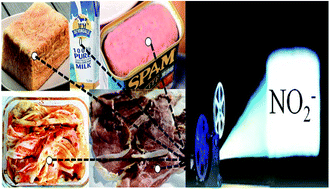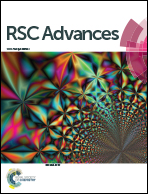A novel ultrasensitive surface plasmon resonance-based nanosensor for nitrite detection†
Abstract
Nitrite is a common food additive, however, its reduction product, nitrosamine, is a strong carcinogen, and hence the ultra-sensitive detection of nitrite is an effective means to prevent related cancers. In this study, different sized gold nanoparticles (AuNPs) were modified with P-aminothiophenol (ATP) and naphthylethylenediamine (NED). In the presence of nitrite, satellite-like AuNPs aggregates formed via the diazotization coupling reaction and the color of the system was changed by the functionalized AuNPs aggregates. The carcinogenic nitrite content could be detected by colorimetry according to the change in the system color. The linear concentration range of sodium nitrite was 0–1.0 μg mL−1 and the detection limit was determined to be 3.0 ng mL−1. Compared with the traditional method, this method has the advantages of high sensitivity, low detection limit, good selectivity and can significantly lower the naked-eye detection limit to 3.0 ng mL−1. In addition, this method is suitable for the determination of nitrite in various foods. We think this novel designed highly sensitive nitrate nanosensor holds great market potential.

- This article is part of the themed collection: Editors' collection: Food Engineering, Science, Technology, and Nutrition


 Please wait while we load your content...
Please wait while we load your content...